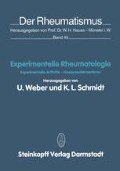Zusammenfassung
In den vergangenen 35 Jahren sind durch die Anstrengungen der experimentellen und klinischen Rheumaforschung zahlreiche entzündungshemmende Pharmaka entwickelt worden, von denen zur Zeit ungefähr 35 Wirkstoffe Eingang in die Rheumatherapie gefunden haben. Da trotz intensiver Bemühungen die ursächlichen Zusammenhänge bei der Entstehung rheumatischer Entzündungen noch nicht völlig aufgeklärt sind, ist es auch nicht verwunderlich, daß wir bis heute noch kein Kausaltherapeutikum zur Behandlung entzündlich-rheumatischer Erkrankungen zur Verfügung haben. Alle bis jetzt bekannten Antirheumatika stellen somit nur Pharmaka dar, die geeignet sind, bestimmte entzündliche Reaktionen sowie einzelne oder mehrere Symptome der rheumatischen Entzündung im therapeutischen Sinne zu beeinflussen.
Access this chapter
Tax calculation will be finalised at checkout
Purchases are for personal use only
Preview
Unable to display preview. Download preview PDF.
Literatur
Arora JS (1968) Indomethacin arthropathy of hips. Proc R Soc Med 61:669
Brandt KD, Palmoski MJ (1983) Proteoglycan content determines the susceptibility of articular cartilage to salicylate-induced suppression of proteoglycan synthesis. J Rheumatol [Suppl 9] 10:78–80
Domenjoz R (1971) The pharmacoloy of antirheumatic agents. In: Müller W, Harwerth HG, Fehr K (eds) Rheumatoid arthritis. Academic Press, London New York p 531–550
Hauge MF (1975) Hofteleddsartrose — Indometacin. Tidsskr Nor Laegeforen 95:1594–1596
Husmann F (1979) Die Wirkungsmechanismen der Antirheumatika. Eine Übersicht. Akt Rheumatol 4:5–17, 45-57, 103-122
Kalbhen DA (1978) Pharmakologische Studien zur Entwicklung eines neuen Arthrosemodells am Versuchstier. (Forschungsberichte des Landes Nordrhein-Westfalen. Nr. 2745. Fachgruppe Medizin.) Westdeutscher Verlag, Opladen
Kalbhen DA (1978) Experimental osteoarthrosis of pharmacological evaluation of anti-arthrotic compounds. Naunyn Schmiedebergs Arch Pharmacol [Suppl] 302:48
Kalbhen DA (1979) Pharmakologische Untersuchungen an einer tierexperimentellen Arthrose. Vortrag: IX. Europäischer Kongreß für Rheumatologie, Wiesbaden, September
Kalbhen DA (1980) Drug induced biochemical changes in cartilage metabolism. In: Nuki G (ed) The aetiopathogenesis of osteoarthrosis. Pitman Medical Publ Tunbridge Wells p 123–138
Kalbhen DA (1982) Einflüsse antirheumatischer Pharmaka auf den Gelenkknorpel. Akt Rheumatol 7:211–217
Kalbhen DA (1982) The inhibitory effects of steroidal and non-steroidal antirheumatic drugs on articular cartilage in osteoarthrosis and its counteraction by a biological GAG-Peptide Complex (Rumalon®). Z Rheumatol 41:202–211
Kalbhen DA (1983) Können Kortikosteroide und nicht-steroidale Antirheumatika Arthrosen induzieren oder fördern? Therapiewoche 33:2597–2603
Kalbhen DA (1984) Können Medikamente Arthrose fördern — können Medikamente Arthrose hemmen? Akt Rheumatol 9:63–71
Kalbhen DA (1984) Biochemically induced osteoarthrosis in the chicken and rat. In: Munthe E, Bjelle A (eds) Effects of drugs on osteoarthrosis. Huber, Bern Stuttgart Vienna, p 48–68
Kalbhen DA, Domenjoz R (1977) Angriffspunkte steroidaler und nicht-steroidaler Symptomatika bei entzündlich-rheumatischen Erkrankungen. Akt Rheumatol 2:29–37
Kalbhen DA, Blum U, Schiller G (1976) Experimental osteoarthrosis induced by antirheumatic drugs. Naunyn Schmiedebergs Arch. Pharmacol [Suppl] 293:40
Kalbhen DA, Wentsche B, Peil M, Witassek F (1976) The effect of different antirheumatic drugs on connective tissue after intraarticular injection. A new study on osteoarthrosis. Arch Int Physiol [Suppl] 84:43
Kalbhen DA, Schauer M, Wentsche B (1978) Tierexperimentelle Untersuchungen über den Einfluß intraartikulär applizierter Antiphlogistika/Antirheumatika auf den Gelenkknorpel in vivo. Z Rheumatol 37:380–394
Karzel K (1967) Der Einfluß von Antiphlogistika auf Lebens-und Vermehrungsfähigkeit normaler und neoplastischer Zellen in vitro. Arch Int Pharmacodyn 169:70–82
Karzel K, Peters HD, Hack G (1971) Zum Nachweis von Antiphlogistikawirkungen auf die Vermehrung und den Vermehrungsstoffwechsel teilungsfähiger Zellen in vivo. Int J Clin Pharmacol 5:203–205
Maier R, Wilhelmi G (1981) Der Einfluß antiinflammatorisch aktiver Pharmaka auf die spontane Arthrose der Maus C 57 black. In: Korst JK van der (Hrsg) Ein neues antirheumatisch-analgetisches Medikament: Pirprofen (Rengasil®). Ein internationales Symposium über Pirprofen am IX. Europäischen Kongreß für Rheumatologie, Wiesbaden, September 1979. Huber, Bern Stuttgart Wien, S 93–101
Maier R, Wilhelmi G (1982) Spezielle pharmakologische Befunde. In: Kass E (Hrsg) Voltaren® — neue Ergebnisse. Ein internationales Symposium über Voltaren am XV. Internationalen Kongreß für Rheumatologie, Paris, Juni 1981. Huber, Bern Stuttgart Wien, S 11–18
Maier R, Wilhelmi G (1982) Neue experimentelle Ergebnisse über Knorpeldestruktion und-protektion. Kassenarzt 22:36–39
Maier R, Wilhelmi G (1984) Preclinical investigations of drug effects in models of osteoarthrosis. In: Munthe E, Bjelle A (eds) Effects of drugs on osteoarthrosis. Huber, Bern Stuttgart Vienna, p 90–96
Mathies H (1979) Zum Wirkungsmechanismus der Antirheumatika. Triangel (Sandoz) 18:63–73
McKenzie LS, Horsburgh BA, Ghosh P, Taylor TKF (1976) Osteoarthrosis. Uncertain rationale for anti-inflammatory drug therapy. Lancet 1:908–909
McKenzie LS, Horsburgh BA, Ghosh P, Taylor TKF (1976) Effect of anti-inflammatory drugs on sulphated glycosaminoglycan synthesis in aged human articular cartilage. Ann Rheum Dis 35:487–497
Miner JC (1972) Osteoarthritis of the hip and indomethacin. J Bone Joint Surg [B] 54:752
Palmoski MJ, Brandt KD (1980) Effects of some nonsteroidal anti-inflammatory drugs on proteoglycan metabolism and organization in canine articular cartilage. Arthritis Rheum 23:1010–1020
Palmoski MJ, Brandt KD (1982) Aspirin aggravates the degeneration of canine joint cartilage caused by immobilization. Arthritis Rheum 25:1333–1342
Rønningen H, Langeland N (1979) Indomethacin treatment in osteoarthritis of the hip joint. Does the treatment interfere with the natural course of the disease? Acta Orthop Scand 50:169–174
Serup J, Ovesen JO (1981) Salicylate-arthropathy. Accelerated coxarthrosis during long-term treatment with acetylsalicylic acid. Schweiz Rdsch Med (Praxis) 70:359–361
Trnavsky K (1974) Some effects of antiinflammatory drugs on connective tissue metabolism. In: Scherrer RA, Whitehouse MW (eds) Antiinflammatory agents. Chemistry and pharmacology vol 2. Academic Press, New York (Medicinal chemistry. A series of monographs. Vol 13), p 303–326
Watson M (1976) The suppressing effect of indomethacin on articular cartilage. Rheumatol Rehabil 15:26–30
Wilhelmi G, Maier R (1983) Medikamentöse Beeinflussung des Knorpels im Experiment. In: Gelenkknorpel und Arthrose. Huber, Bern Stuttgart Wien, S 41–63
Author information
Authors and Affiliations
Editor information
Editors and Affiliations
Rights and permissions
Copyright information
© 1986 Dr. Dietrich Steinkopff Verlag, GmbH & Co. KG, Darmstadt
About this paper
Cite this paper
Kalbhen, D.A. (1986). Zur antiphlogistischen Wirkung nicht steroidaler Antirheumatika und ihr Einfluß auf die artikuläre Knorpelzelle. In: Weber, U., Schmidt, K.L. (eds) Experimentelle Rheumatologie. Der Rheumatismus, vol 45. Steinkopff. https://doi.org/10.1007/978-3-642-85356-2_28
Download citation
DOI: https://doi.org/10.1007/978-3-642-85356-2_28
Publisher Name: Steinkopff
Print ISBN: 978-3-7985-0690-9
Online ISBN: 978-3-642-85356-2
eBook Packages: Springer Book Archive

